Economics Essay: The Widening Gap Between Wealthy and Poor
VerifiedAdded on 2020/02/18
|5
|1346
|71
Essay
AI Summary
This essay examines the growing income inequality and the widening gap between the wealthy and the poor. It begins by defining income inequality and highlighting the increasing disparity in wealth distribution, citing statistics that illustrate the widening gap in OECD countries and Australia. The essay then delves into the major factors contributing to this trend, including wage determination, globalization, technological advancements, and the role of education. It explains how globalization and technology impact employment trends, the changing nature of jobs, and the skills required. The essay also discusses how access to education and training is often limited by financial constraints, further exacerbating income inequality. The conclusion reinforces the concept of income inequality as a key issue and emphasizes the impact of these factors on the evolving employment landscape.
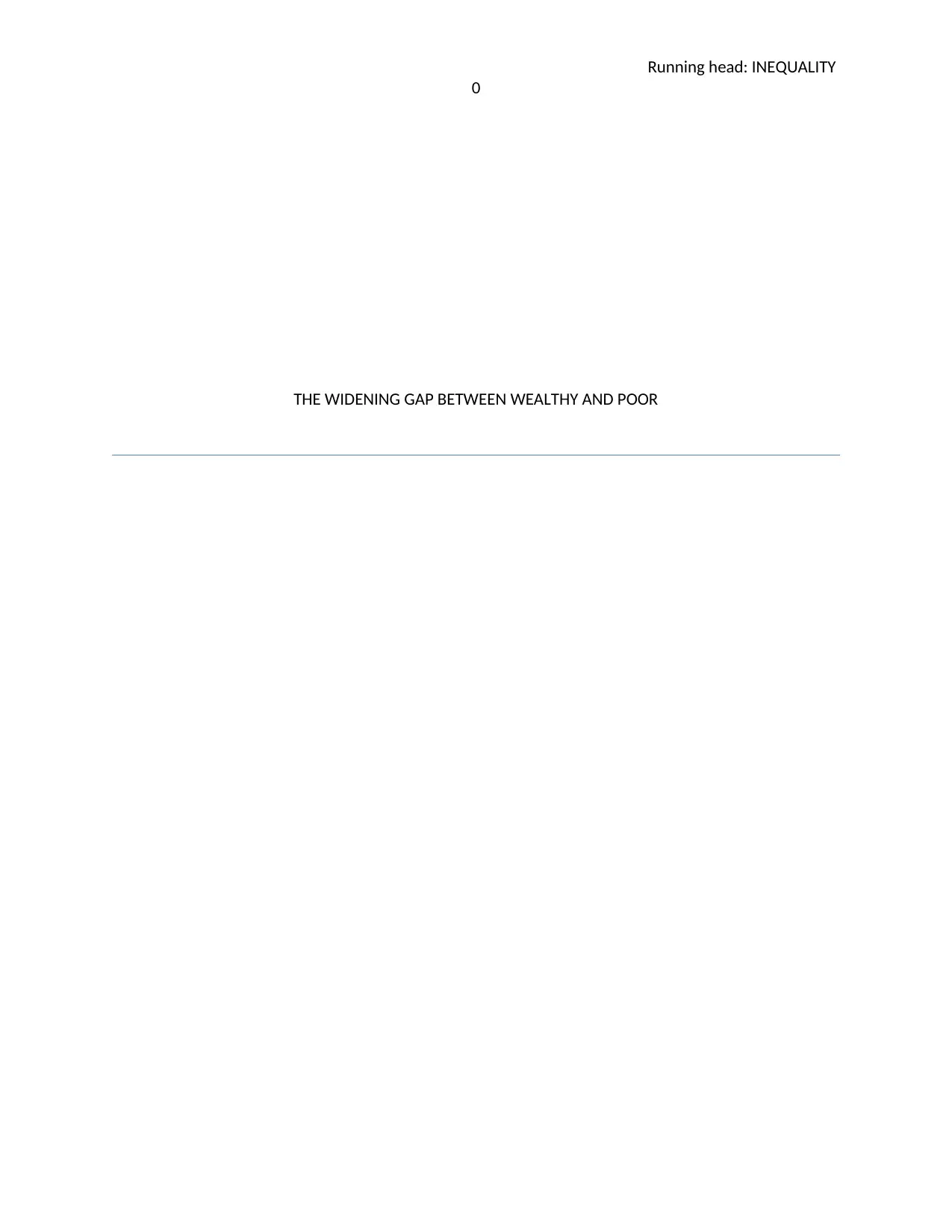
Running head: INEQUALITY
0
THE WIDENING GAP BETWEEN WEALTHY AND POOR
0
THE WIDENING GAP BETWEEN WEALTHY AND POOR
Paraphrase This Document
Need a fresh take? Get an instant paraphrase of this document with our AI Paraphraser
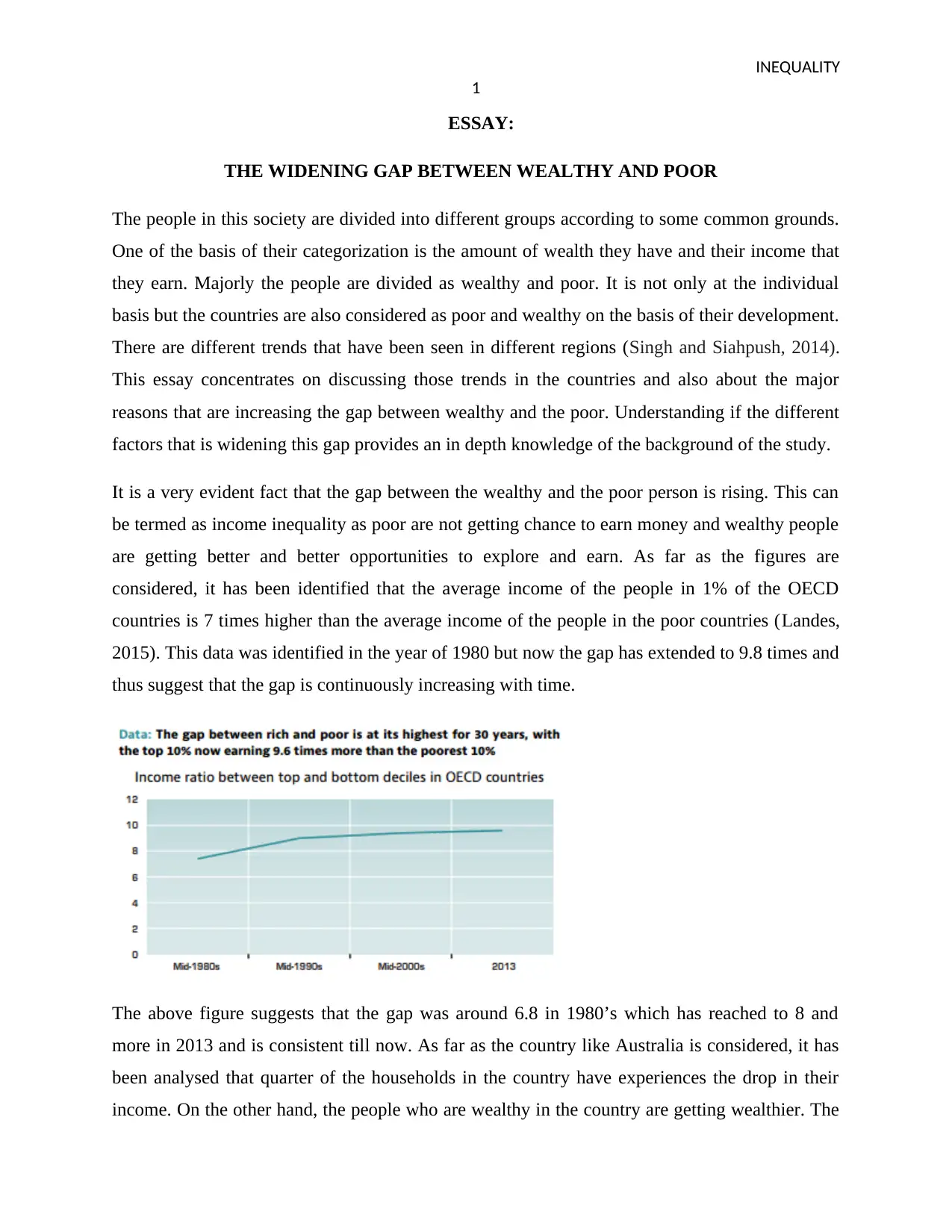
INEQUALITY
1
ESSAY:
THE WIDENING GAP BETWEEN WEALTHY AND POOR
The people in this society are divided into different groups according to some common grounds.
One of the basis of their categorization is the amount of wealth they have and their income that
they earn. Majorly the people are divided as wealthy and poor. It is not only at the individual
basis but the countries are also considered as poor and wealthy on the basis of their development.
There are different trends that have been seen in different regions (Singh and Siahpush, 2014).
This essay concentrates on discussing those trends in the countries and also about the major
reasons that are increasing the gap between wealthy and the poor. Understanding if the different
factors that is widening this gap provides an in depth knowledge of the background of the study.
It is a very evident fact that the gap between the wealthy and the poor person is rising. This can
be termed as income inequality as poor are not getting chance to earn money and wealthy people
are getting better and better opportunities to explore and earn. As far as the figures are
considered, it has been identified that the average income of the people in 1% of the OECD
countries is 7 times higher than the average income of the people in the poor countries (Landes,
2015). This data was identified in the year of 1980 but now the gap has extended to 9.8 times and
thus suggest that the gap is continuously increasing with time.
The above figure suggests that the gap was around 6.8 in 1980’s which has reached to 8 and
more in 2013 and is consistent till now. As far as the country like Australia is considered, it has
been analysed that quarter of the households in the country have experiences the drop in their
income. On the other hand, the people who are wealthy in the country are getting wealthier. The
1
ESSAY:
THE WIDENING GAP BETWEEN WEALTHY AND POOR
The people in this society are divided into different groups according to some common grounds.
One of the basis of their categorization is the amount of wealth they have and their income that
they earn. Majorly the people are divided as wealthy and poor. It is not only at the individual
basis but the countries are also considered as poor and wealthy on the basis of their development.
There are different trends that have been seen in different regions (Singh and Siahpush, 2014).
This essay concentrates on discussing those trends in the countries and also about the major
reasons that are increasing the gap between wealthy and the poor. Understanding if the different
factors that is widening this gap provides an in depth knowledge of the background of the study.
It is a very evident fact that the gap between the wealthy and the poor person is rising. This can
be termed as income inequality as poor are not getting chance to earn money and wealthy people
are getting better and better opportunities to explore and earn. As far as the figures are
considered, it has been identified that the average income of the people in 1% of the OECD
countries is 7 times higher than the average income of the people in the poor countries (Landes,
2015). This data was identified in the year of 1980 but now the gap has extended to 9.8 times and
thus suggest that the gap is continuously increasing with time.
The above figure suggests that the gap was around 6.8 in 1980’s which has reached to 8 and
more in 2013 and is consistent till now. As far as the country like Australia is considered, it has
been analysed that quarter of the households in the country have experiences the drop in their
income. On the other hand, the people who are wealthy in the country are getting wealthier. The
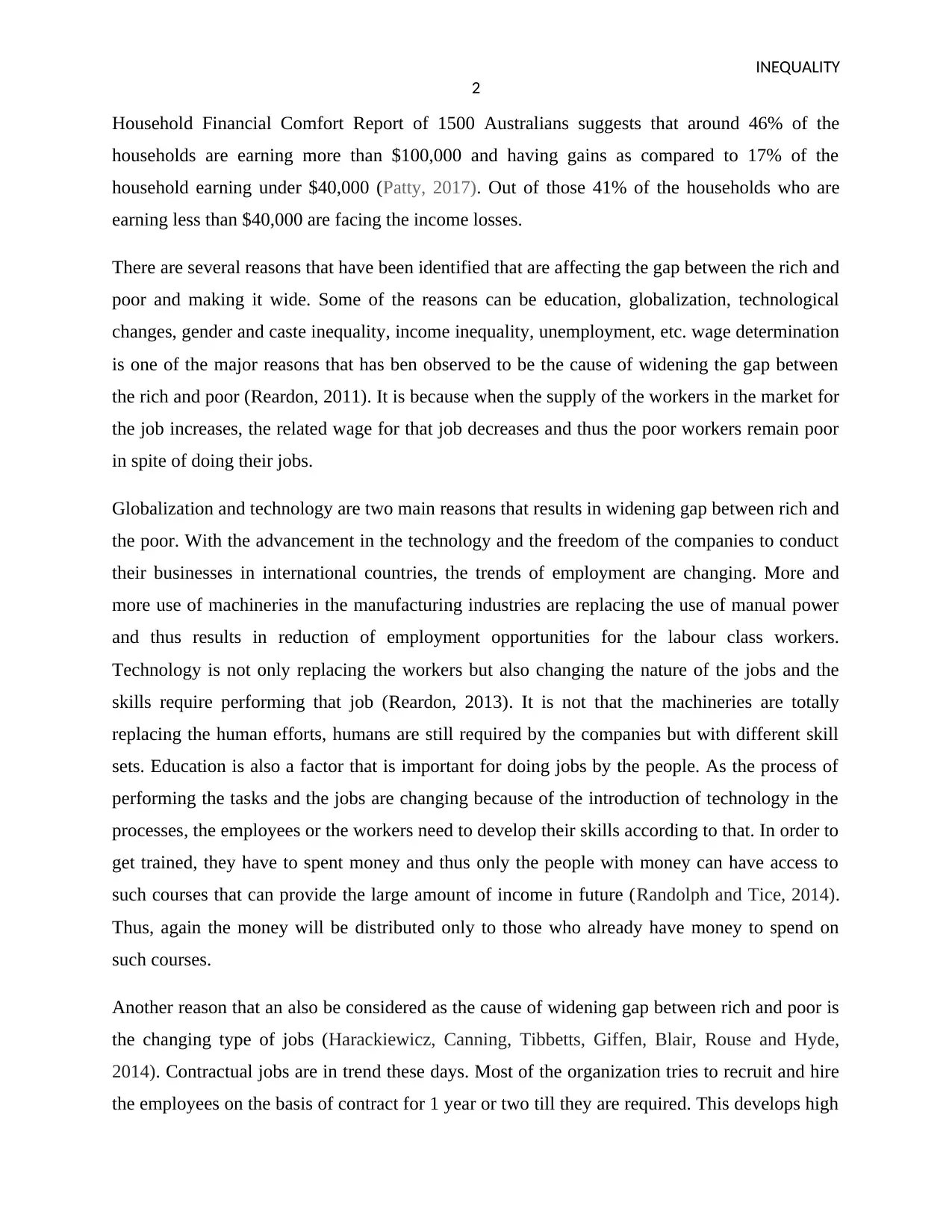
INEQUALITY
2
Household Financial Comfort Report of 1500 Australians suggests that around 46% of the
households are earning more than $100,000 and having gains as compared to 17% of the
household earning under $40,000 (Patty, 2017). Out of those 41% of the households who are
earning less than $40,000 are facing the income losses.
There are several reasons that have been identified that are affecting the gap between the rich and
poor and making it wide. Some of the reasons can be education, globalization, technological
changes, gender and caste inequality, income inequality, unemployment, etc. wage determination
is one of the major reasons that has ben observed to be the cause of widening the gap between
the rich and poor (Reardon, 2011). It is because when the supply of the workers in the market for
the job increases, the related wage for that job decreases and thus the poor workers remain poor
in spite of doing their jobs.
Globalization and technology are two main reasons that results in widening gap between rich and
the poor. With the advancement in the technology and the freedom of the companies to conduct
their businesses in international countries, the trends of employment are changing. More and
more use of machineries in the manufacturing industries are replacing the use of manual power
and thus results in reduction of employment opportunities for the labour class workers.
Technology is not only replacing the workers but also changing the nature of the jobs and the
skills require performing that job (Reardon, 2013). It is not that the machineries are totally
replacing the human efforts, humans are still required by the companies but with different skill
sets. Education is also a factor that is important for doing jobs by the people. As the process of
performing the tasks and the jobs are changing because of the introduction of technology in the
processes, the employees or the workers need to develop their skills according to that. In order to
get trained, they have to spent money and thus only the people with money can have access to
such courses that can provide the large amount of income in future (Randolph and Tice, 2014).
Thus, again the money will be distributed only to those who already have money to spend on
such courses.
Another reason that an also be considered as the cause of widening gap between rich and poor is
the changing type of jobs (Harackiewicz, Canning, Tibbetts, Giffen, Blair, Rouse and Hyde,
2014). Contractual jobs are in trend these days. Most of the organization tries to recruit and hire
the employees on the basis of contract for 1 year or two till they are required. This develops high
2
Household Financial Comfort Report of 1500 Australians suggests that around 46% of the
households are earning more than $100,000 and having gains as compared to 17% of the
household earning under $40,000 (Patty, 2017). Out of those 41% of the households who are
earning less than $40,000 are facing the income losses.
There are several reasons that have been identified that are affecting the gap between the rich and
poor and making it wide. Some of the reasons can be education, globalization, technological
changes, gender and caste inequality, income inequality, unemployment, etc. wage determination
is one of the major reasons that has ben observed to be the cause of widening the gap between
the rich and poor (Reardon, 2011). It is because when the supply of the workers in the market for
the job increases, the related wage for that job decreases and thus the poor workers remain poor
in spite of doing their jobs.
Globalization and technology are two main reasons that results in widening gap between rich and
the poor. With the advancement in the technology and the freedom of the companies to conduct
their businesses in international countries, the trends of employment are changing. More and
more use of machineries in the manufacturing industries are replacing the use of manual power
and thus results in reduction of employment opportunities for the labour class workers.
Technology is not only replacing the workers but also changing the nature of the jobs and the
skills require performing that job (Reardon, 2013). It is not that the machineries are totally
replacing the human efforts, humans are still required by the companies but with different skill
sets. Education is also a factor that is important for doing jobs by the people. As the process of
performing the tasks and the jobs are changing because of the introduction of technology in the
processes, the employees or the workers need to develop their skills according to that. In order to
get trained, they have to spent money and thus only the people with money can have access to
such courses that can provide the large amount of income in future (Randolph and Tice, 2014).
Thus, again the money will be distributed only to those who already have money to spend on
such courses.
Another reason that an also be considered as the cause of widening gap between rich and poor is
the changing type of jobs (Harackiewicz, Canning, Tibbetts, Giffen, Blair, Rouse and Hyde,
2014). Contractual jobs are in trend these days. Most of the organization tries to recruit and hire
the employees on the basis of contract for 1 year or two till they are required. This develops high
⊘ This is a preview!⊘
Do you want full access?
Subscribe today to unlock all pages.

Trusted by 1+ million students worldwide
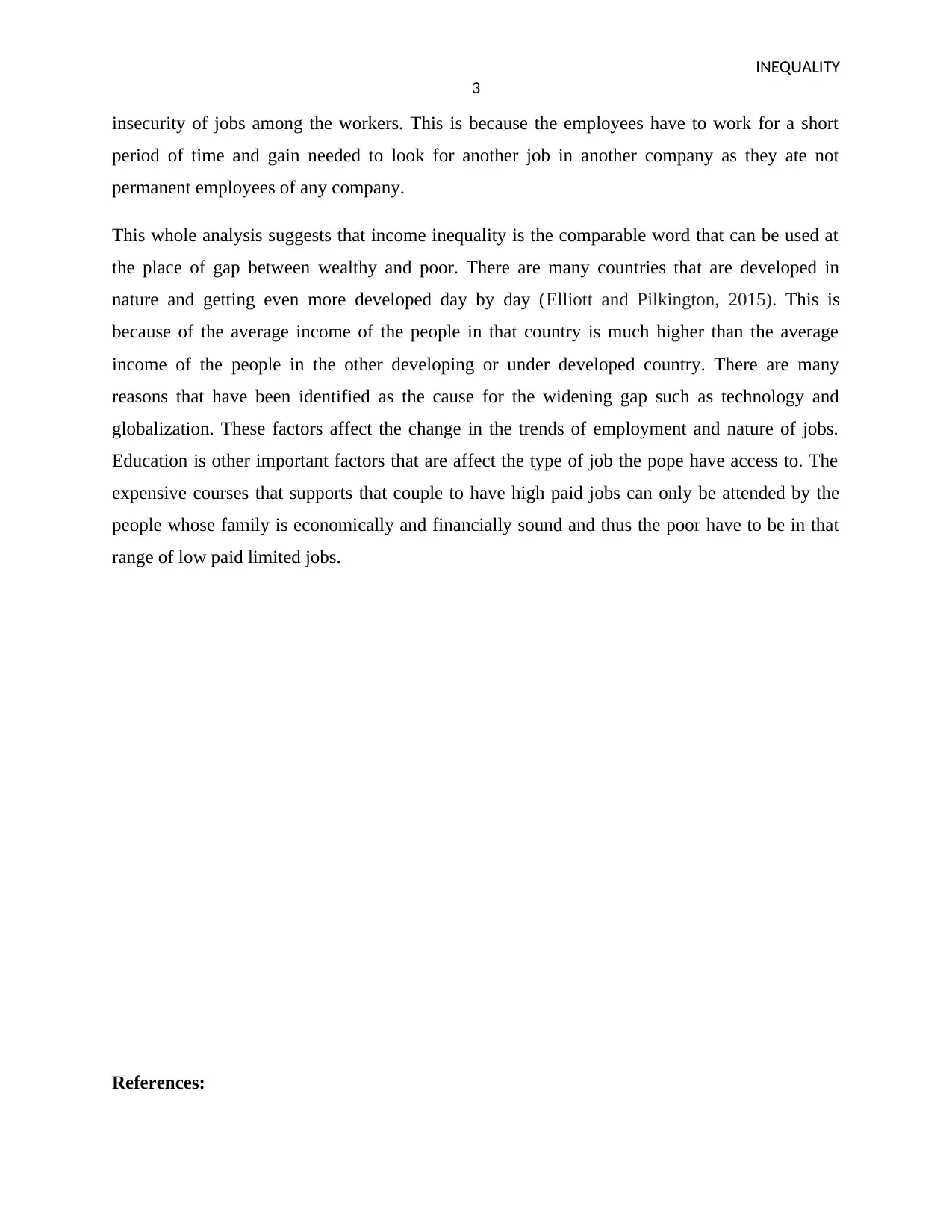
INEQUALITY
3
insecurity of jobs among the workers. This is because the employees have to work for a short
period of time and gain needed to look for another job in another company as they ate not
permanent employees of any company.
This whole analysis suggests that income inequality is the comparable word that can be used at
the place of gap between wealthy and poor. There are many countries that are developed in
nature and getting even more developed day by day (Elliott and Pilkington, 2015). This is
because of the average income of the people in that country is much higher than the average
income of the people in the other developing or under developed country. There are many
reasons that have been identified as the cause for the widening gap such as technology and
globalization. These factors affect the change in the trends of employment and nature of jobs.
Education is other important factors that are affect the type of job the pope have access to. The
expensive courses that supports that couple to have high paid jobs can only be attended by the
people whose family is economically and financially sound and thus the poor have to be in that
range of low paid limited jobs.
References:
3
insecurity of jobs among the workers. This is because the employees have to work for a short
period of time and gain needed to look for another job in another company as they ate not
permanent employees of any company.
This whole analysis suggests that income inequality is the comparable word that can be used at
the place of gap between wealthy and poor. There are many countries that are developed in
nature and getting even more developed day by day (Elliott and Pilkington, 2015). This is
because of the average income of the people in that country is much higher than the average
income of the people in the other developing or under developed country. There are many
reasons that have been identified as the cause for the widening gap such as technology and
globalization. These factors affect the change in the trends of employment and nature of jobs.
Education is other important factors that are affect the type of job the pope have access to. The
expensive courses that supports that couple to have high paid jobs can only be attended by the
people whose family is economically and financially sound and thus the poor have to be in that
range of low paid limited jobs.
References:
Paraphrase This Document
Need a fresh take? Get an instant paraphrase of this document with our AI Paraphraser
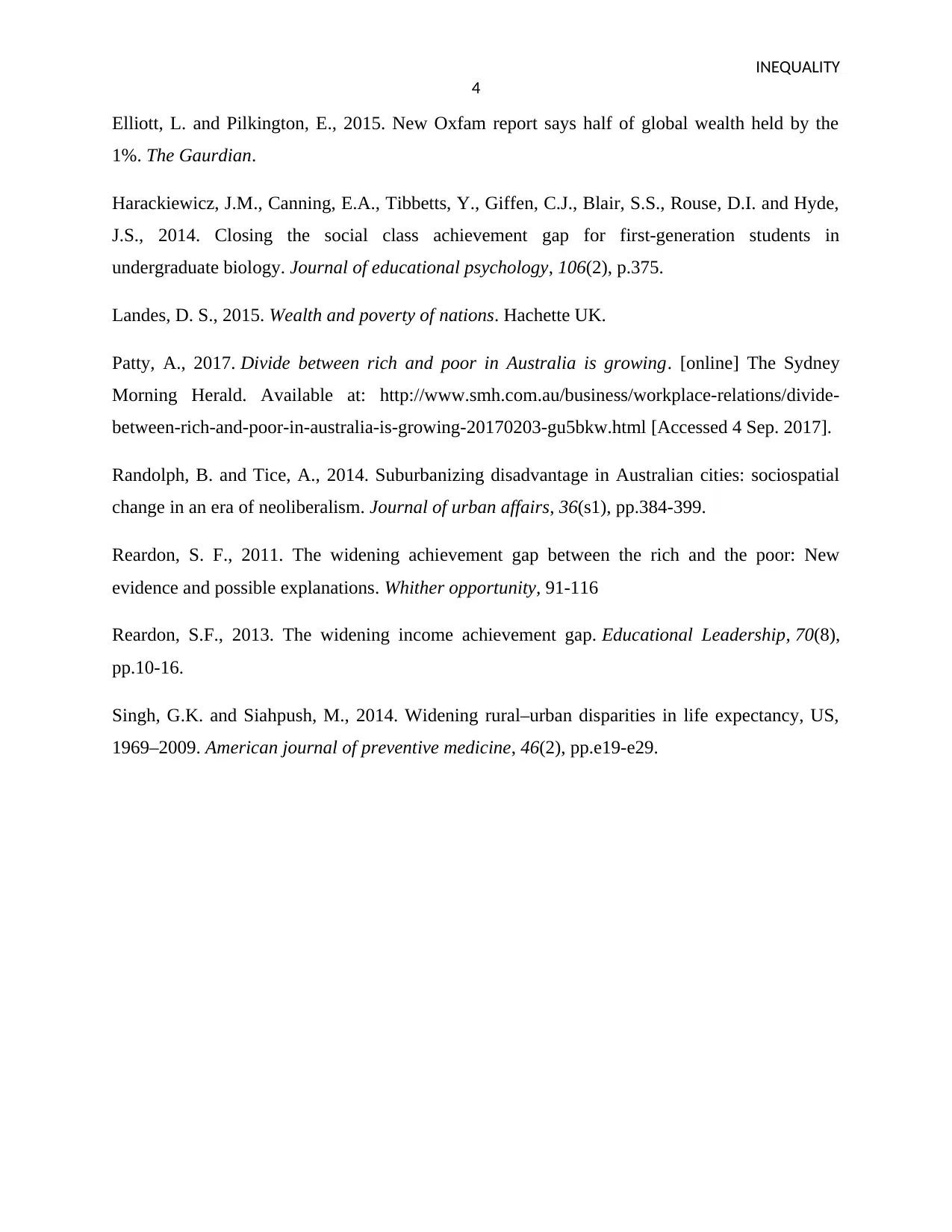
INEQUALITY
4
Elliott, L. and Pilkington, E., 2015. New Oxfam report says half of global wealth held by the
1%. The Gaurdian.
Harackiewicz, J.M., Canning, E.A., Tibbetts, Y., Giffen, C.J., Blair, S.S., Rouse, D.I. and Hyde,
J.S., 2014. Closing the social class achievement gap for first-generation students in
undergraduate biology. Journal of educational psychology, 106(2), p.375.
Landes, D. S., 2015. Wealth and poverty of nations. Hachette UK.
Patty, A., 2017. Divide between rich and poor in Australia is growing. [online] The Sydney
Morning Herald. Available at: http://www.smh.com.au/business/workplace-relations/divide-
between-rich-and-poor-in-australia-is-growing-20170203-gu5bkw.html [Accessed 4 Sep. 2017].
Randolph, B. and Tice, A., 2014. Suburbanizing disadvantage in Australian cities: sociospatial
change in an era of neoliberalism. Journal of urban affairs, 36(s1), pp.384-399.
Reardon, S. F., 2011. The widening achievement gap between the rich and the poor: New
evidence and possible explanations. Whither opportunity, 91-116
Reardon, S.F., 2013. The widening income achievement gap. Educational Leadership, 70(8),
pp.10-16.
Singh, G.K. and Siahpush, M., 2014. Widening rural–urban disparities in life expectancy, US,
1969–2009. American journal of preventive medicine, 46(2), pp.e19-e29.
4
Elliott, L. and Pilkington, E., 2015. New Oxfam report says half of global wealth held by the
1%. The Gaurdian.
Harackiewicz, J.M., Canning, E.A., Tibbetts, Y., Giffen, C.J., Blair, S.S., Rouse, D.I. and Hyde,
J.S., 2014. Closing the social class achievement gap for first-generation students in
undergraduate biology. Journal of educational psychology, 106(2), p.375.
Landes, D. S., 2015. Wealth and poverty of nations. Hachette UK.
Patty, A., 2017. Divide between rich and poor in Australia is growing. [online] The Sydney
Morning Herald. Available at: http://www.smh.com.au/business/workplace-relations/divide-
between-rich-and-poor-in-australia-is-growing-20170203-gu5bkw.html [Accessed 4 Sep. 2017].
Randolph, B. and Tice, A., 2014. Suburbanizing disadvantage in Australian cities: sociospatial
change in an era of neoliberalism. Journal of urban affairs, 36(s1), pp.384-399.
Reardon, S. F., 2011. The widening achievement gap between the rich and the poor: New
evidence and possible explanations. Whither opportunity, 91-116
Reardon, S.F., 2013. The widening income achievement gap. Educational Leadership, 70(8),
pp.10-16.
Singh, G.K. and Siahpush, M., 2014. Widening rural–urban disparities in life expectancy, US,
1969–2009. American journal of preventive medicine, 46(2), pp.e19-e29.
1 out of 5
Related Documents
Your All-in-One AI-Powered Toolkit for Academic Success.
+13062052269
info@desklib.com
Available 24*7 on WhatsApp / Email
![[object Object]](/_next/static/media/star-bottom.7253800d.svg)
Unlock your academic potential
Copyright © 2020–2025 A2Z Services. All Rights Reserved. Developed and managed by ZUCOL.





